
Sun Yat-sen was a Chinese statesman, physician, and political philosopher who served as the first provisional president of the Republic of China and the first leader of the Kuomintang. He is called the "Father of the Nation" in the Republic of China, and the "Forerunner of the Revolution" in the People's Republic of China for his instrumental role in the overthrow of the Qing dynasty during the Xinhai Revolution. Sun is unique among 20th-century Chinese leaders for being widely revered by both the Communist Party in Mainland China and the Nationalist Party in Taiwan.

Toronto Chinatowns are ethnic enclaves in Toronto, Ontario, Canada, with a high concentration of ethnic Chinese residents and businesses. These neighbourhoods are major cultural, social and economic hubs for the Chinese-Canadian communities of the region. In addition to Toronto, several areas in the Greater Toronto Area also hold a high concentration of Chinese residents and businesses.

Chinatown is a neighborhood in Downtown Los Angeles, California, that became a commercial center for Chinese and other Asian businesses in Central Los Angeles in 1938. The area includes restaurants, shops, and art galleries, but also has a residential neighborhood with a low-income, aging population of about 20,000 residents.
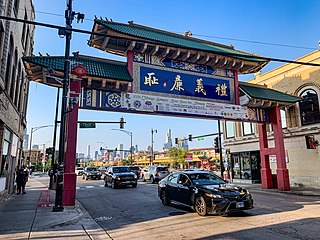
Chinatown is a neighborhood on the South Side of Chicago, along S. Wentworth Avenue between Cermak Road and W. 26th St. Over a third of Chicago's Chinese population resides in this ethnic enclave, making it one of the largest concentrations of Chinese-Americans in the United States. It formed around 1912, after settlers moved south from near the Loop, where the first enclaves were established in the 19th century.

Morris Abraham Cohen, better known as Two-Gun Cohen, was a Polish-born British and Canadian adventurer of Jewish origin who became aide-de-camp to Sun Yat-sen and a major-general in the Chinese National Revolutionary Army.
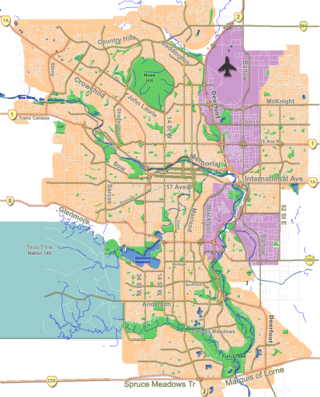
Kensington is a Business Revitalization Zone (BRZ) in Calgary, Alberta, focused around the intersection of Kensington Road and 10th St. NW, also known as the Kensington-Louise Crossing Business Association. It is located in the communities of Hillhurst and Sunnyside, immediately north of downtown and the Bow River, and is easily reached by most of the city's major access routes.

International Avenue is a Business Revitalization Zone (BRZ) in Calgary, Alberta. The district is centered on 17 Avenue SE in the neighbourhood of Forest Lawn in the east of the city. The district was created in 1993 to celebrate the rich cultural diversity that exists in east central Calgary. The area has since become a popular location for ethnic restaurants and shopping.

Downtown Calgary is a dense urban district in central Calgary, Alberta. It contains the second largest concentration of head offices in Canada, despite only being the country's fourth largest city in terms of population. The downtown is divided into several residential, commercial, corporate, and mixed-use neighbourhoods, including the Financial District (CBD), Eau Claire, Chinatown, East Village, Beltline, and the West End.

East Vancouver is a region within the city of Vancouver, British Columbia, Canada. Geographically, East Vancouver is bordered to the north by Burrard Inlet, to the south by the Fraser River, and to the east by the city of Burnaby. East Vancouver is divided from Vancouver's "West Side" by Ontario Street.

Chinatown is an neighbourhood in Winnipeg, Manitoba, that was formed in 1909 and serves as an enclave of Chinese expatriates.
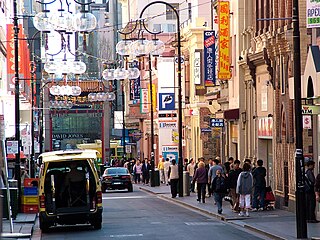
Chinatown is an ethnic enclave in the Central Business District (CBD) of Melbourne, Victoria, Australia. Centred at the eastern end of Little Bourke Street, it extends between the corners of Swanston and Spring streets, and consists of numerous laneways, alleys and arcades. Established in the 1850s during the Victorian gold rush, it is notable for being the longest continuous ethnic Chinese settlement in the Western World and the oldest Chinatown in the Southern Hemisphere.
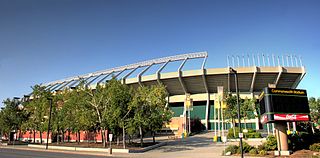
McCauley is a vibrant and ethnically diverse inner city neighbourhood in Edmonton, Alberta undergoing revitalization. It is named for Matthew McCauley, the first mayor of Edmonton, and is located just to the north east of the Downtown core. McCauley is famous as the home of dozens of religious buildings concentrated in a small area as well as being a large venue for the 1978 Commonwealth Games.

The first Brooklyn Chinatown, was originally established in the Sunset Park area of the New York City borough of Brooklyn. It is one of the largest and fastest growing ethnic Chinese enclaves outside of Asia, as well as within New York City itself. Because this Chinatown is rapidly evolving into an enclave predominantly of Fuzhou immigrants from Fujian Province in China, it is now increasingly common to refer to it as the Little Fuzhou or Fuzhou Town of the Western Hemisphere; as well as the largest Fuzhou enclave of New York City.

Chinatowns are enclaves of Chinese people outside of China. The first Chinatown in the United States was San Francisco's Chinatown in 1848, and many other Chinatowns were established in the 19th century by the Chinese diaspora on the West Coast. By 1875, Chinatowns had emerged in eastern cities such as New York City, Boston, and Philadelphia. The Chinese Exclusion Act of 1882 barred Chinese immigration to the United States, but the Magnuson Act of 1943 repealed it, and the population of Chinatowns began to rise again. In the 2010s, the downturn in the U.S. economy caused many Chinese Americans to return to China.
Chinatowns in Canada generally exist in the large cities of Vancouver, Ottawa, Calgary, Edmonton, Toronto, and Montreal, and existed in some smaller towns throughout the history of Canada. Prior to 1900, almost all Chinese were located in British Columbia, but have spread throughout Canada thereafter. From 1923 to 1967, immigration from China was suspended due to exclusion laws. In 1997, the handover of Hong Kong to China caused many from there to flee to Canada due to uncertainties. Canada had about 25 Chinatowns across the country between the 1930s to 1940s, some of which have ceased to exist.

A Chinatown developed in Phoenix in the 1870s as the predominantly single male Chinese population self-segregated primarily to provide cultural support to each other in a place where they faced significant discrimination. They came to dominate certain types of jobs and made an impression on the greater community with their celebrations of Chinese holidays. Other aspects of their culture, primarily gambling and the smoking of opium were viewed less favorably, and in the 1890s, they were forced to establish a new Chinatown several blocks away from the prior prime downtown location, where their community would be "less visible".

First Chinatown is a retronym for a former neighbourhood in Toronto, an area that once served as the city's Chinatown. The city's original Chinatown existed from the 1890s to the 1970s, along York Street and Elizabeth Street between Queen and Dundas Streets within St. John's Ward. However, more than two thirds of it was expropriated and razed starting in the late 1950s to build the new Toronto City Hall and its civic square, Nathan Phillips Square.
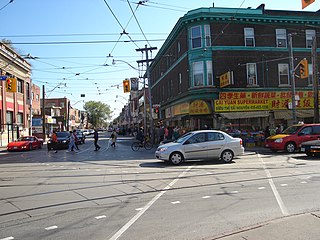
East Chinatown is a Chinese neighbourhood located in the city of Toronto's east end in Riverdale and one of the several Chinatowns in Toronto. It was formed during the early 1970s and is centred on Gerrard Street East between Broadview Avenue and Carlaw Avenue.

Chinatown, Toronto also known as Downtown Chinatown or West Chinatown is a Chinese ethnic enclave located in the city's downtown core of Toronto, Ontario, Canada. It is centred at the intersections of Spadina Avenue and Dundas Street, West.



















